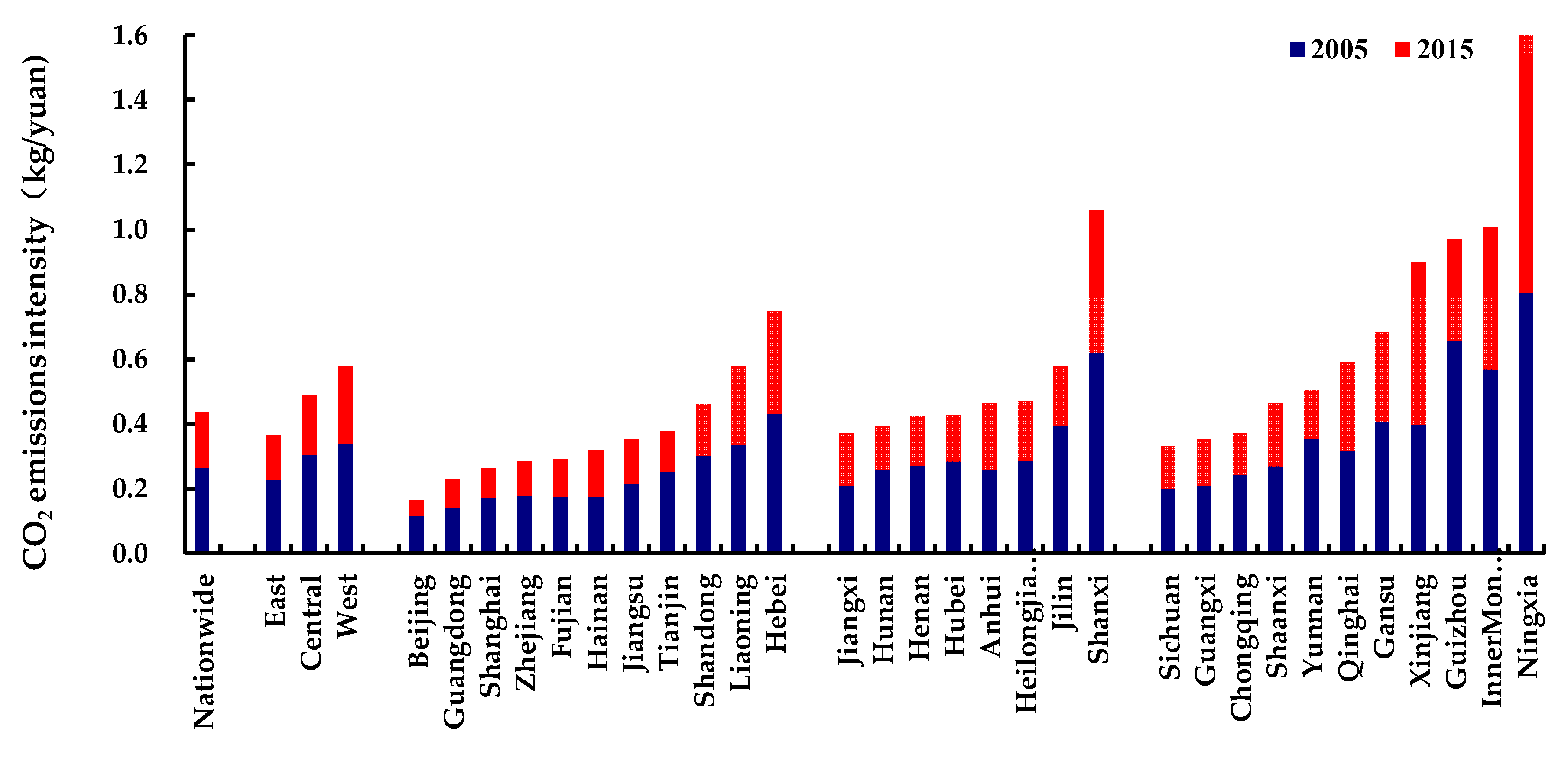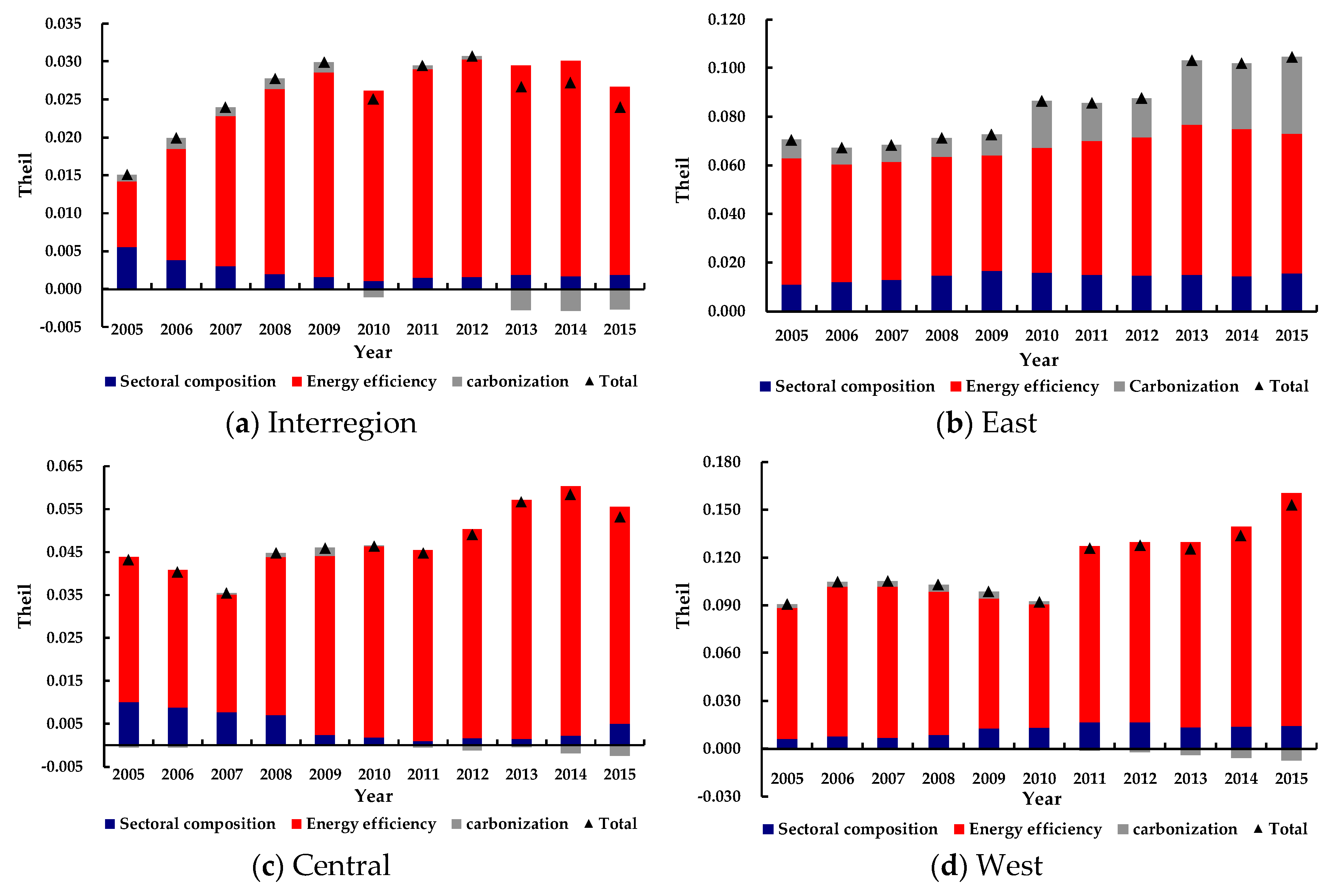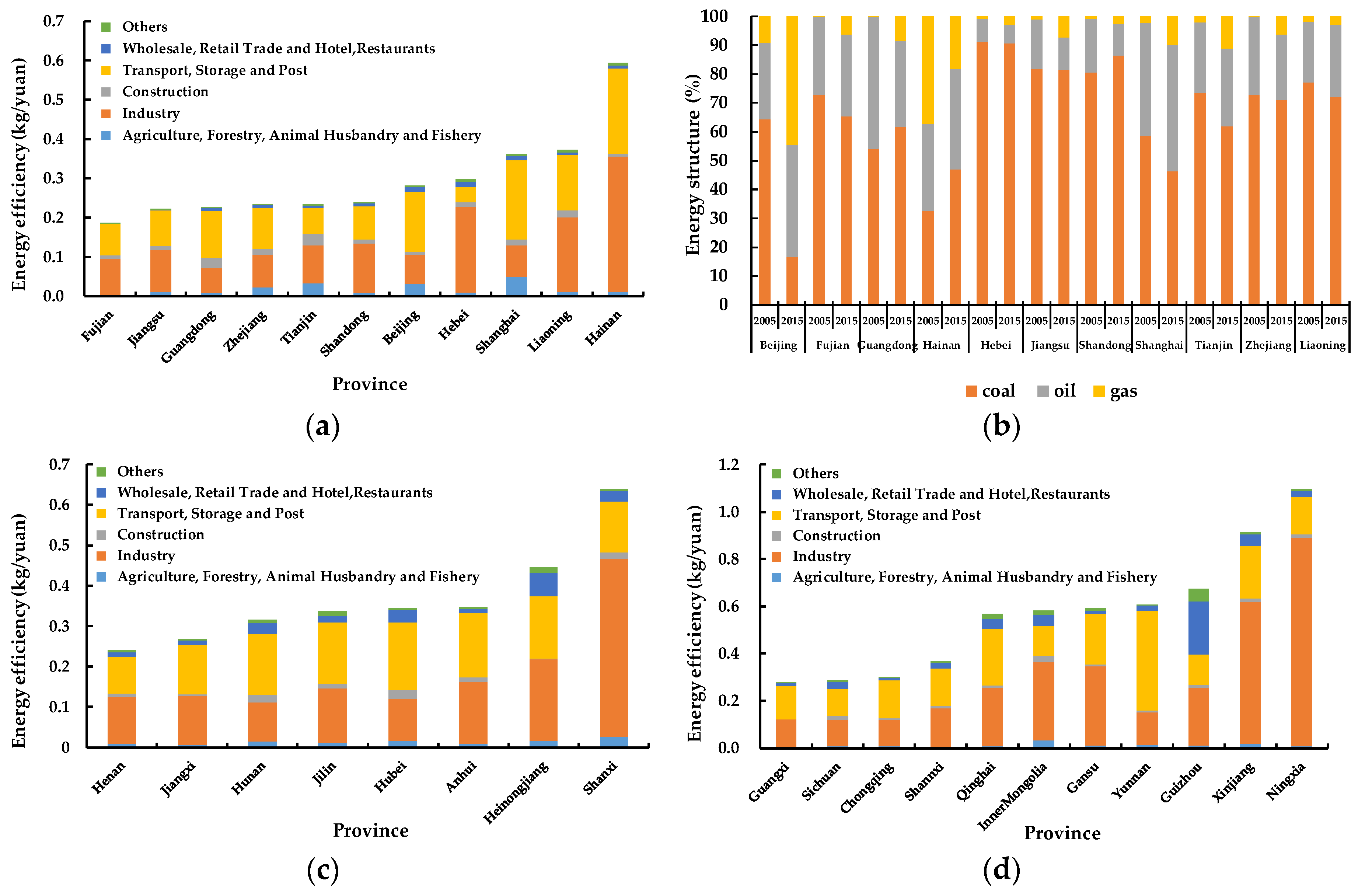Provincial-Level CO2 Emissions Intensity Inequality in China: Regional Source and Explanatory Factors of Interregional and Intraregional Inequalities
Abstract
1. Introduction
2. Literature Review
3. Materials and Methods
3.1. Measuring CO2 Emissions Intensity Inequality
3.2. Decomposing CO2 Emissions Intensity Inequality by Regions
3.3. Decomposing CO2 Emissions Intensity Inequality by Factors
3.4. Data
4. Results
4.1. Spatial and Temporal Distribution of CO2 Emissions Intensity in China
4.2. CO2 Emissions Intensity Inequality Measurement according to the Theil Index and the Regional Decomposition of It
4.3. Factor Decomposition of Interregional and Intraregional Inequalities in CO2 Emissions Intensity in China
5. Discussion and Policy Implications
6. Conclusions
Author Contributions
Funding
Conflicts of Interest
Appendix A. Decomposing CO2 Emissions Intensity Inequality by Factors
References
- Zhang, H.; Shen, L.; Zhong, S.; Elshkaki, A. Economic structure transformation and low-carbon development in energy-rich cities: The case of the contiguous area of Shanxi and Shaanxi provinces, and Inner Mongolia autonomous region of China. Sustainability 2020, 12, 1875. [Google Scholar] [CrossRef]
- Duro, J.A.; Teixidó-Figueras, J.; Padilla, E. Empirics of the international inequality in CO2 emissions intensity: Explanatory factors according to complementary decomposition methodologies. Environ. Resour. Econ. 2016, 63, 57–77. [Google Scholar] [CrossRef]
- Wang, N.; Satola, D.; Wiberg, A.H.; Liu, C.; Gustavsen, A. Reduction strategies for greenhouse gas emissions from high-speed railway station buildings in a cold climate zone of China. Sustainability 2020, 12, 1704. [Google Scholar] [CrossRef]
- Wang, S.; Liu, Y.; Fang, C. Review of energy-related CO2 emission in response to climate change. Prog. Geogr. 2015, 34, 151–164. (In Chinese) [Google Scholar]
- National Development and Reform Commission of the People’s Republic of China (NDRC). Available online: https://www4.unfccc.int/sites/submissions/indc/Submission%20Pages/submissions.aspx (accessed on 5 May 2019).
- Chen, J.; Cheng, S.; Song, M.; Wang, J. Interregional differences of coal carbon dioxide emissions in China. Energy Policy 2016, 96, 1–13. [Google Scholar] [CrossRef]
- Yan, Y.M.; Wang, Z.; Wu, L.Y.; Liu, C.X. Analysis of the determinants of carbon emission intensity on regional differences. Acta Sci. Circumst. 2016, 36, 3436–3444. (In Chinese) [Google Scholar]
- Wang, J.; Yang, Y. Regional carbon emission intensity disparities in China based on the decomposition method of Shapley value. Resour. Sci. 2014, 36, 557–566. (In Chinese) [Google Scholar]
- Chan, K.W.; Wang, M. Remapping China’s regional inequalities, 1990–2006: A new assessment of de facto and de jure population data. Eurasian Geogr. Econ. 2008, 49, 21–55. [Google Scholar] [CrossRef]
- Guan, Y.; Huang, G.; Liu, L.; Zhai, M.; Xu, X. Measurement of air-pollution inequality through a three-perspective accounting model. Sci. Total Environ. 2019, 696, 133937. [Google Scholar] [CrossRef]
- National Bureau of Statistics of the People’s Republic of China (NBS). China Statistical Yearbook; China Statistics Press: Beijing, China, 2006. [Google Scholar]
- National Bureau of Statistics of the People’s Republic of China (NBS). China Statistical Yearbook; China Statistics Press: Beijing, China, 2016. [Google Scholar]
- Clarke-Sather, A.; Qu, J.; Wang, Q.; Zeng, J.; Li, Y. Carbon inequality at the sub-national scale: A case study of provincial-level inequality in CO2 emissions in China 1997–2007. Energy Policy 2011, 39, 5420–5428. [Google Scholar] [CrossRef]
- Heil, M.T.; Wodon, Q.T. Future inequality in CO2 emissions and the impact of abatement proposals. Environ. Resour. Econ. 2000, 17, 163–181. [Google Scholar] [CrossRef]
- Heil, M.T.; Wodon, Q.T. Inequality in CO2 emissions between poor and rich countries. J. Environ. Dev. 1997, 6, 426–452. [Google Scholar] [CrossRef]
- Mussini, M.; Grossi, L. Decomposing changes in CO2 emission inequality over time: The roles of re-ranking and changes in per capita CO2 emission disparities. Energy Econ. 2015, 49, 274–281. [Google Scholar] [CrossRef]
- Wang, S.J.; Su, Y.X.; Zhao, Y.B. Regional inequality, spatial spillover effects and influencing factors of China’s city-level energy-related carbon emissions. Acta Geogr. Sin. 2018, 73, 414–428. (In Chinese) [Google Scholar]
- Wang, S.; Liu, X. China’s city-level energy-related CO2 emissions: Spatiotemporal patterns and driving forces. Appl. Energy 2017, 200, 204–214. [Google Scholar] [CrossRef]
- Duro, J.A.; Teixidó-Figueras, J.; Padilla, E. The causal factors of international inequality in CO2 emissions per capita: A regression-based inequality decomposition analysis. Environ. Resour. Econ. 2017, 67, 683–700. [Google Scholar] [CrossRef]
- Wang, S.; Fang, C.; Wang, Y. Spatiotemporal variations of energy-related CO2 emissions in China and its influencing factors: An empirical analysis based on provincial panel data. Renew. Sustain. Energy Rev. 2016, 55, 505–515. [Google Scholar] [CrossRef]
- Ezcurra, R. Is there cross-country convergence in carbon dioxide emissions? Energy Policy 2007, 35, 1363–1372. [Google Scholar] [CrossRef]
- Camarero, M.; Picazo-Tadeo, A.J.; Tamarit, C. Are the determinants of CO2 emissions converging among OECD countries? Econ. Lett. 2013, 118, 159–162. [Google Scholar] [CrossRef]
- Remuzgo, L.; Sarabia, J.M. International inequality in CO2 emissions: A new factorial decomposition based on Kaya factors. Environ. Sci. Policy 2015, 54, 15–24. [Google Scholar] [CrossRef]
- Grunewald, N.; Jakob, M.; Mouratiadou, I. Decomposing inequality in CO2 emissions: The role of primary energy carriers and economic sectors. Ecol. Econ. 2014, 100, 183–194. [Google Scholar] [CrossRef]
- Chen, J.; Cheng, S.; Song, M. Decomposing inequality in energy-related CO2 emissions by source and source increment: The roles of production and residential consumption. Energy Policy 2017, 107, 698–710. [Google Scholar] [CrossRef]
- Wang, H.; Zhou, P. Assessing global CO2 emission inequality from consumption perspective: An index decomposition analysis. Ecol. Econ. 2018, 154, 257–271. [Google Scholar] [CrossRef]
- Duro, J.A.; Padilla, E. International inequalities in per capita CO2 emissions: A decomposition methodology by Kaya factors. Energy Econ. 2006, 28, 170–187. [Google Scholar] [CrossRef]
- Duro, J.A. Weighting vectors and international inequality changes in environmental indicators: An analysis of CO2 per capita emissions and Kaya factors. Energy Econ. 2013, 39, 122–127. [Google Scholar] [CrossRef]
- Padilla, E.; Duro, J.A. Explanatory factors of CO2 per capita emission inequality in the European Union. Energy Policy 2013, 62, 1320–1328. [Google Scholar] [CrossRef]
- Phillips, P.C.B.; Sul, D. Transition modeling and econometric convergence tests. Econometrica 2007, 75, 1771–1855. [Google Scholar] [CrossRef]
- Zhao, Y.T.; Huang, X.J.; Zhong, T.Y.; Peng, J.W. Spatial pattern evolution of carbon emission intensity from energy consumption in China. Environ. Sci. 2011, 32, 3145–3152. (In Chinese) [Google Scholar]
- Yang, Q.; Liu, H.J. Regional differences and convergence of carbon intensity distribution in China: Based on an empirical study of provincial data 1995–2009. Contemp. Financ. Econ. 2012, 2, 87–98. (In Chinese) [Google Scholar]
- Sun, Y.H.; Zhong, W.Z.; Qing, D.R. Analysis on differences of carbon emission intensity of each province in China based on Theil index. Financ. Trade Res. 2012, 3, 1–7. (In Chinese) [Google Scholar]
- Li, R.; Jiang, X. Inequality of carbon intensity: Empirical analysis of China 2000–2014. Sustainability 2017, 9, 711. [Google Scholar] [CrossRef]
- Zhou, J.Q.; Wang, T.S. Convergence of regional economic growth and carbon intensity difference and its mechanism: Empirical analysis based on China’s provincial panel data. Soc. Sci. Res. 2014, 5, 66–73. (In Chinese) [Google Scholar]
- Duro, J.A. On the automatic application of inequality indexes in the analysis of the international distribution of environmental indicators. Ecol. Econ. 2012, 76, 1–7. [Google Scholar] [CrossRef]
- Bourguignon, F. Decomposable income inequality measures. Econometrica 1979, 47, 901–920. [Google Scholar] [CrossRef]
- Choi, K.H.; Ang, B.W. Decomposition aggregate energy intensity changes in two measures: Ratio and difference. Energy Econ. 2003, 25, 615–624. [Google Scholar] [CrossRef]
- Sun, J.W.; Ang, B.W. Some properties of an exact energy decomposition model. Energy 2000, 25, 1177–1188. [Google Scholar] [CrossRef]
- Intergovernmental Panel on Climate Change (IPCC). Guidelines for National Greenhouse Gas Inventories; Institute for Global Environmental Strategies (IGES): Hayama, Japan, 2006. [Google Scholar]
- National Bureau of Statistics of the People’s Republic of China (NBS). China Energy Statistical Yearbook; China Statistics Press: Beijing, China, 2006–2016. [Google Scholar]
- National Development and Reform Commission of the People’s Republic of China (NDRC). Guidelines for Provincial Greenhouse Gas Inventories; National Development and Reform Commission of the People’s Republic of China (NDRC): Beijing, China, 2011. [Google Scholar]
- National Bureau of Statistics of the People’s Republic of China (NBS). China Statistical Yearbook; China Statistics Press: Beijing, China, 2006–2015. [Google Scholar]
- Yue, C.; Hu, X.Y.; He, C.F.; Zhu, J.L.; Wang, S.P.; Fang, J.Y. Provincial carbon emissions and carbon intensity in China from 1995 to 2007: Carbon emissions and social development Ⅲ. Acta Sci. Nat. Univ. Pekin. 2010, 46, 510–516. (In Chinese) [Google Scholar]
- Aldy, J.E. Per capita carbon dioxide emissions: Convergence or divergence? Environ. Resour. Econ. 2006, 33, 533–555. [Google Scholar] [CrossRef]
- Commoner, B. Population, development, and the environment: Trends and key issues in the developed countries. Int. J. Health Serv. 1993, 23, 519–539. [Google Scholar] [CrossRef]
- Commoner, B. Rapid population growth and environmental stress. Int. J. Health Serv. 1991, 21, 199–227. [Google Scholar] [CrossRef]



| CO2 Emissions Intensity Inequality | Interregional Component | Intraregional Component | |
|---|---|---|---|
| 2005 | 0.083 | 0.015 (18%) | 0.068 (82%) |
| 2006 | 0.087 | 0.020 (23%) | 0.067 (77%) |
| 2007 | 0.091 | 0.024 (26%) | 0.067 (74%) |
| 2008 | 0.098 | 0.028 (28%) | 0.07 (72%) |
| 2009 | 0.101 | 0.030 (30%) | 0.071 (70%) |
| 2010 | 0.103 | 0.025 (24%) | 0.078 (76%) |
| 2011 | 0.112 | 0.029 (26%) | 0.083 (74%) |
| 2012 | 0.116 | 0.031 (26%) | 0.086 (74%) |
| 2013 | 0.123 | 0.027 (22%) | 0.096 (78%) |
| 2014 | 0.125 | 0.027 (22%) | 0.097 (78%) |
| 2015 | 0.125 | 0.024 (19%) | 0.101 (81%) |
| East | Central | West | |||||||
|---|---|---|---|---|---|---|---|---|---|
| Internal Theil (Tg) | GDP % (pg) | Absolute Contribution | Internal Theil (Tg) | GDP %(pg) | Absolute Contribution | Internal Theil (Tg) | GDP % (pg) | Absolute Contribution | |
| 2005 | 0.071 | 60% | 0.042 | 0.043 | 23% | 0.010 | 0.091 | 17% | 0.015 |
| 2006 | 0.067 | 60% | 0.040 | 0.040 | 23% | 0.009 | 0.105 | 17% | 0.018 |
| 2007 | 0.068 | 60% | 0.041 | 0.035 | 23% | 0.008 | 0.105 | 17% | 0.018 |
| 2008 | 0.071 | 60% | 0.042 | 0.045 | 23% | 0.010 | 0.103 | 17% | 0.017 |
| 2009 | 0.073 | 59% | 0.043 | 0.046 | 23% | 0.011 | 0.099 | 17% | 0.017 |
| 2010 | 0.087 | 59% | 0.051 | 0.046 | 24% | 0.011 | 0.092 | 17% | 0.016 |
| 2011 | 0.086 | 58% | 0.050 | 0.045 | 24% | 0.011 | 0.126 | 18% | 0.022 |
| 2012 | 0.088 | 58% | 0.051 | 0.049 | 24% | 0.012 | 0.127 | 18% | 0.023 |
| 2013 | 0.103 | 58% | 0.060 | 0.057 | 24% | 0.014 | 0.125 | 18% | 0.023 |
| 2014 | 0.102 | 58% | 0.059 | 0.058 | 24% | 0.014 | 0.134 | 18% | 0.025 |
| 2015 | 0.105 | 57% | 0.060 | 0.053 | 24% | 0.013 | 0.153 | 19% | 0.028 |
| ΔTSd | ΔTEd | ΔTCd | ΔTp | ΔT | |
|---|---|---|---|---|---|
| 2005/2010 | |||||
| Interregion | −0.005 | 0.020 | −0.002 | −0.003 | 0.010 |
| East | 0.008 | 0.002 | 0.012 | −0.006 | 0.016 |
| Central | −0.011 | 0.008 | 0.001 | 0.006 | 0.003 |
| West | 0.011 | −0.006 | 0.000 | −0.003 | 0.001 |
| 2010/2015 | |||||
| Interregion | 0.000 | 0.008 | −0.002 | −0.008 | −0.001 |
| East | 0.003 | 0.005 | 0.013 | −0.003 | 0.018 |
| Central | 0.004 | −0.002 | −0.002 | 0.007 | 0.007 |
| West | 0.001 | 0.065 | −0.009 | 0.005 | 0.061 |
| 2005/2015 | |||||
| Interregion | −0.006 | 0.028 | −0.004 | −0.010 | 0.009 |
| East | 0.011 | 0.008 | 0.025 | −0.010 | 0.034 |
| Central | −0.007 | 0.002 | −0.001 | 0.015 | 0.010 |
| West | 0.013 | 0.058 | −0.010 | 0.001 | 0.062 |
© 2020 by the authors. Licensee MDPI, Basel, Switzerland. This article is an open access article distributed under the terms and conditions of the Creative Commons Attribution (CC BY) license (http://creativecommons.org/licenses/by/4.0/).
Share and Cite
Jiang, W.; Liu, W. Provincial-Level CO2 Emissions Intensity Inequality in China: Regional Source and Explanatory Factors of Interregional and Intraregional Inequalities. Sustainability 2020, 12, 2529. https://doi.org/10.3390/su12062529
Jiang W, Liu W. Provincial-Level CO2 Emissions Intensity Inequality in China: Regional Source and Explanatory Factors of Interregional and Intraregional Inequalities. Sustainability. 2020; 12(6):2529. https://doi.org/10.3390/su12062529
Chicago/Turabian StyleJiang, Wanbei, and Weidong Liu. 2020. "Provincial-Level CO2 Emissions Intensity Inequality in China: Regional Source and Explanatory Factors of Interregional and Intraregional Inequalities" Sustainability 12, no. 6: 2529. https://doi.org/10.3390/su12062529
APA StyleJiang, W., & Liu, W. (2020). Provincial-Level CO2 Emissions Intensity Inequality in China: Regional Source and Explanatory Factors of Interregional and Intraregional Inequalities. Sustainability, 12(6), 2529. https://doi.org/10.3390/su12062529





